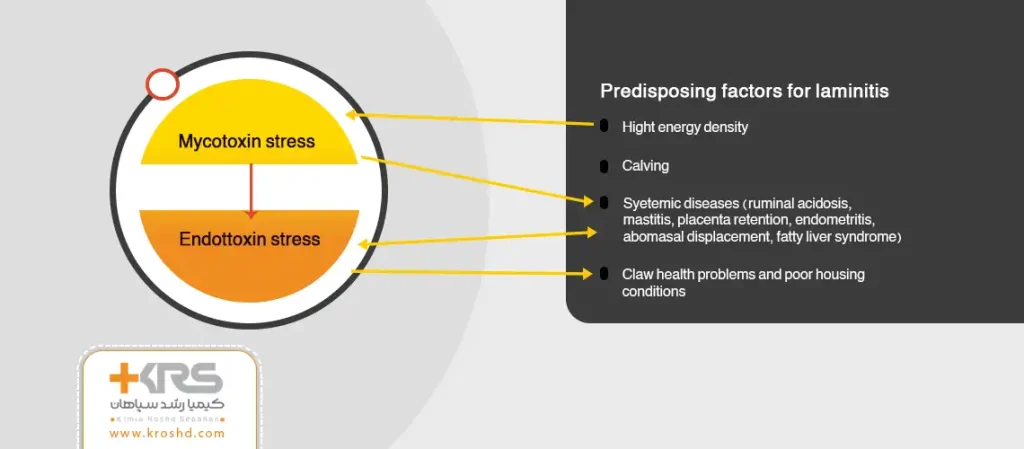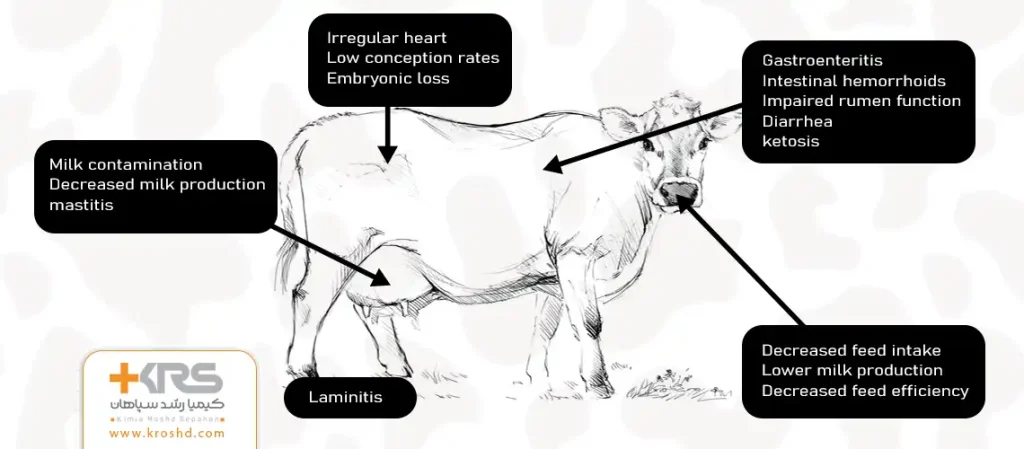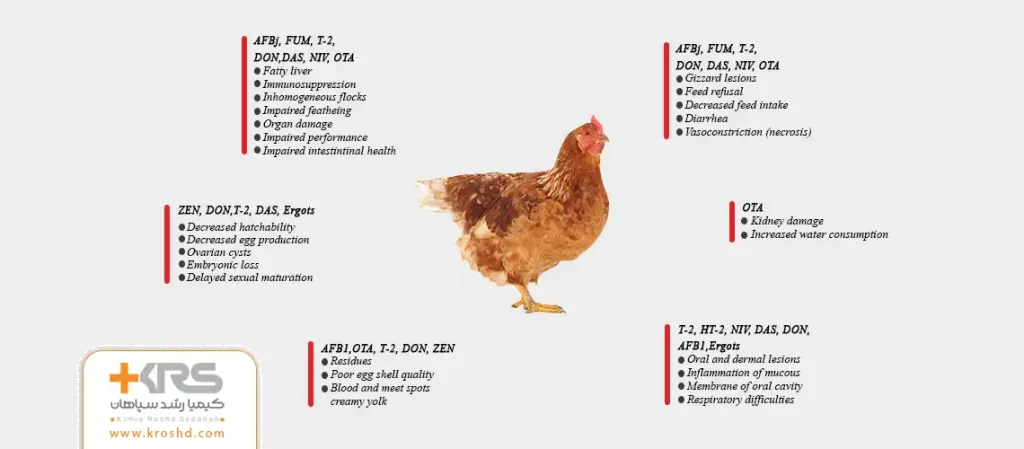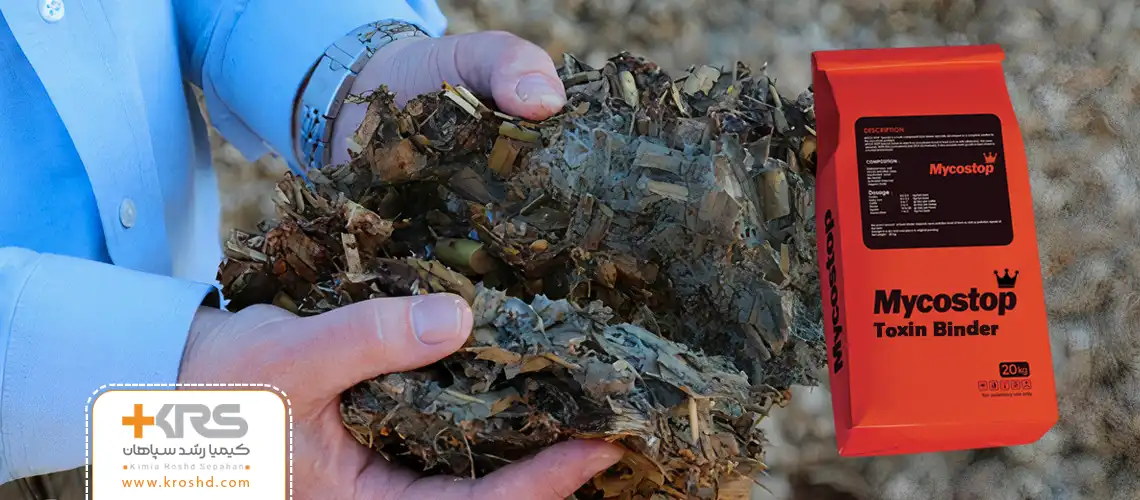What is toxin binder?
Toxin binders are nutritionally inert substances that are added to livestock feed to bind to mycotoxins in the digestive tract and reduce their bioavailability. Toxin binder prevents the absorption of toxins through the intestines and blood circulation They can be effective when other preventative measures have failed to combat mold. Controlling feed regularly for fungal contamination is not an easy task, and the use of absorbents is commonly used as a safety measure and to reassure the customer.
Related products: Toxin binder quality: 5 Key Criteria for Evaluating
Mycotoxins in dairy cattle diet
Over 500 different mycotoxins have been identified to date and often feeds contain many different mycotoxins. We know that mycotoxins are “toxins” and their insidious effects on cattle are deleterious, many, and manifold. Yet the problem of mycotoxins in feed has been largely ignored. The widespread nature of the problem and the long-term effects on cattle health and performance have not been fully appreciated. The word “mycotoxin” literally means “fungus-poison.” Mycotoxins are secondary metabolites produced by molds and fungi in fields and during the storage of grains, feeds, and forages. Mycotoxins are considered to be soil-borne pathogens. Not all molds and fungi will produce mycotoxins, however.

What is the mechanism of action of mycotoxins?
- Reduction of feed intake
- Reduced nutrition (reduced nutrient content of the feed, reduced nutrient absorption, and altered nutrient metabolism)
- Immunosuppression
- Mutagenicity
- Teratogenicity
- Cellular death

type of toxin binders
- Silicate Products
- Clay mineral
- organic / Inorganic polymers
- Carbon Products
Different types of materials have the ability to bind to mycotoxin. The most common bonding agents are aluminosilicates , clay and zeolite. These are natural adsorbents that include hydrated sodium calcium aluminosilicates, bentonite, and zeolite. Most toxin binders are effective adsorbents for aflatoxins. Other items with the ability to bind to mycotoxins are the cell wall components of yeasts. Some studies have shown that cell wall β-glucan of yeasts such as Saccharomyces Cerevisiae can be effective in binding a wide range of toxins. Unlike clay, they can be added at low levels
Related article: livestock supplement: which is the best for your herd?
What is the mechanism of action of toxin binders?
Silicate Products
Silicates are divided into subclasses, not by their chemistries, but by their structures. The silicate subclasses include neo-silicates (single tetrahedrons), sorosilicates (double tetrahedrons), inosilicates (single and double chains), cyclosilicates (rings), phyllosilicates (sheets), tectosilicate (frameworks). Silicates investigated as adsorbent materials are classified primarily as phyllosilicates and tectosilicates. Perhaps the most extensively studied of these materials is one designated a hydrated sodium calcium aluminosilicate (HSCAS). It is suggested that this specific silicate mineral can bind with aflatoxin by chelating the β-dicarbonyl moiety in aflatoxin with uncoordinated metal ions in the clay materials. Other silicates that have been studied include bentonites, zeolites, and clinoptilolites. The clay group is a subcategory of the phyllosilicates. Bentonite is a general clay material originating from volcanic ash and containing primarily montmorillonite as the main constituent. Montmorillonite clay is a hydrated sodium calcium aluminum magnesium silicate hydroxide. Clays are silica sheets that are similar to other phyllosilicates but contain a high concentration of water. Zeolites are classified as tectosilicates consisting of interlocking tetrahedrons. The zeolite structure provides vacant spaces that form channels of various sizes allowing the movement of molecules into and out of the structure. Zeolites can lose and absorb water without damage to their crystal structures. Much of the pioneering work with mycotoxin binders was done with silicates and specifically with the HSCAS material. Specific HSCAS included at 0.5% to 2.0% of the diet is well documented to adsorb aflatoxin and to prevent aflatoxicosis across species. Responses to HSCAS appear to be dose-dependent. This HSCAS is characterized as an “aflatoxin-selective clay,” is not a good adsorbent of other mycotoxins, and therefore, is not expected to be protective against feeds containing multiple mycotoxins. Cyclopiazonic acid, which has co-occurred with aflatoxin, is not adsorbed by HSCAS. Similarly, little effect was seen, using a silicate material, ochratoxin toxicity but did demonstrate reduced T-2 toxicity. Montmorillonite binds well with sterigmatocystin, a mycotoxin chemically similar to aflatoxin. Various clay products including calcium bentonite reduce aflatoxin residues in the milk of dairy cows. Several products were effective; however, sodium bentonite reduced milk aflatoxin more than a similar amount of calcium bentonite. Diatomaceous earth has shown the potential in vitro to bind aflatoxin, sterigmatocystin, T-2 toxin, zearalenone, and ochratoxin. Zeolites have not been proven to reduce the toxicity of T-2 toxin. Several studies have shown that chemical modifications have increased the binding of HSCAS with zearalenone, aflatoxin, ochratoxin, and zearalenone by octadecyl dimethyl benzyl ammonium-treated zeolite.
Clay mineral
The clay group is a subcategory of the phyllosilicates. Bentonite is a general clay material originating from volcanic ash and containing primarily montmorillonite as the main constituent.
Much of the pioneering work with mycotoxin binders was done with silicates and specifically with the HSCAS material. Specific HSCAS included at 0.5% to 2.0% of the diet is well documented to adsorb aflatoxin and to prevent aflatoxicosis across species. Responses to HSCAS appear to be dose-dependent.
Montmorillonite clay is a hydrated sodium calcium aluminum magnesium silicate hydroxide. Clays are silica sheets that are similar to other phyllosilicates but contain a high concentration of water. Zeolites are classified as tectosilicates consisting of interlocking tetrahedrons. The zeolite structure provides vacant spaces that form channels of various sizes allowing the movement of molecules into and out of the structure. Zeolites can lose and absorb water without damage to their crystal structures.
organic / Inorganic polymers
Some complex indigestible carbohydrates (cellulose, polysaccharides in the cell walls of yeast and bacteria such as glucomannans, peptidoglycans, and others), and synthetic polymers such as cholestyramine and polyvinylpyrrolidone can adsorb mycotoxins. Indigestible dietary fiber has absorbance potential for mycotoxins. Alfalfa fiber has reduced the effects of zearalenone.
Saccharomyces cerevisiae live yeast was shown to reduce the detrimental effects of aflatoxin. Fibrous material from the yeast cell wall was shown to have the potential to bind several mycotoxins. Esterified glucomannan polymer extracted from the yeast cell wall was shown to bind with aflatoxin, ochratoxin, and T-2 toxin, individually and combined. Additions of esterified glucomannan at 0.5 or 1.0 g/kg to diets supplying 2 mg of total aflatoxin resulted in dose-dependent responses in broiler chicks. The addition of esterified glucan polymer to aflatoxin-contaminated diets of dairy cows has significantly reduced milk aflatoxin residues as per one study. The esterified glucan polymer may have the capability to bind several mycotoxins. There is a mechanism of binding with zearalenone. A glucan polymer bound both T-2 toxin and zearalenone in vitro. Certain bacteria, particularly strains of lactic acid bacteria, propionibacteria, and bifidobacteria, appear to have the capacity to bind mycotoxins, including aflatoxin and some Fusarium-produced mycotoxins. The binding appears to be physical with deoxynivalenol, diacetoxyscerpenol, nivalenol, and other mycotoxins associated with hydrophobic pockets on the bacterial surface.
Carbon Products
Activated carbon is a general adsorptive material with a large surface area and excellent adsorptive capacity. It has been recommended as a general toxin adsorbing agent and is routinely recommended for various digestive toxicities. The effects of activated charcoal have been variable. Studies showed reduced aflatoxin residues in the milk of cows consuming different sources of charcoal, but responses to charcoal did not exceed that seen with a clay-based binder (a hydrated sodium calcium aluminosilicate or HSCAS). Low levels (45 g/cow daily) of activated carbon did not significantly reduce milk aflatoxin residues, whereas clay-type binders (225 g/cow daily) or an organic polymer of esterified glucan (10 g/cow daily) significantly reduced milk aflatoxin. Responses to charcoal suggest that charcoal may not be as effective in binding aflatoxin as clay-based binders. Activated charcoal may be important in binding zearalenone and/or deoxynivalenol. In an in vitro gastrointestinal model, activated carbon reduced the availability of deoxynivalenol and nivalenol.
The use of toxin binder in cattle feeds
The addition of Toxin binders to contaminated diets has been considered the most promising dietary approach to reduce the effects of Toxins. The theory is that the binder decontaminates mycotoxins in the feed by binding them strongly enough to prevent toxic interactions with the consuming animal and to prevent mycotoxin absorption across the digestive tract. Therefore, this approach is seen as prevention rather than therapy. Potential absorbent materials include activated carbon, aluminosilicates (clay, bentonite, montmorillonite, zeolite, phyllosilicates, etc.), complex indigestible carbohydrates (cellulose, polysaccharides in the cell walls of yeast and bacteria such as glucomannans, peptidoglycans, and others), and synthetic polymers such as cholestyramine and polyvinylpyrrolidone and derivatives.
Livestock enterprises face the maximum loss owed to the contamination of animal feed ingredients and compounded feeds by molds and their toxic metabolites known as mycotoxin. Some of the primary toxigenic molds and mycotoxins are indicated as follows:
What are the effects of not using toxin binders on the health of livestock?
The symptoms of mycotoxicosis in a dairy herd are not always obvious. Whilst mycotoxins can result in acute and obvious symptoms more often than not effects of mycotoxins are sub-clinical and non-specific. They can be wide-ranging depending on the levels and combinations of different mycotoxins involved, disease challenges, animal welfare, stress, and a whole range of other factors.
Recognizing when and to what degree mycotoxins are responsible for poor health and performance can be extremely difficult. The effects can be long-lasting with cows taking many months to fully recover. It is highly likely that mycotoxins predispose animals to disease and are likely to exaggerate the symptoms of disease and also prolong the effects of a disease:
- Reduction of feed intake
- Reduced milk output and reduced butterfat %
- Immunosuppression
- Decrease in rumen efficiency
- Increased disease susceptibility
- Mycotoxins are anti-microbial resulting in changes to rumen and gut microbial populations
- Inflammation and damage to the digestive tract, intestinal hemorrhages, scour
- Reduced nutrient absorption and impaired metabolism
- Effects on endocrine and exocrine systems, hormone, and enzyme levels
- Metabolic problems, retained placentas, ketosis, displaced abomasums, acidosis
- Infertility, metritis, cystic ovaries, poor conception rates, embryo loss, abortion
- Lameness, laminitis, leg swelling, swollen hocks, liver abscesses, udder edema
- Increased somatic cell count and mastitis
- Vaccine and drug failures and reduced effectiveness of antibiotics
- Reduced longevity
The effects of not using toxin binder in poultry feeding?
Poultry is particularly sensitive to the presence of fungal toxins. The results of various research have proven that the contamination of poultry feed with fungal toxins weakens their immune system and leaves damage in the liver, kidney, nervous system, and digestive system. Aflatoxins are the main cause of liver poisoning in poultry. The autopsy symptoms of this poisoning include swelling, paleness, and storage of fat cells in the liver tissue (hemorrhagic fatty liver). Considering that the liver and kidney play a vital role in metabolism and controlling the level of vitamins and minerals, the health of these two organs is very important. The presence of “Ochratoxin A” caused nephropathy in birds that were affected by this poison. Mycotoxins indirectly and by inducing changes in the metabolism of elements involved in bone health such as vitamin D, can cause skeletal and movement disorders in poultry. Also, fungal toxins can affect the health and function of the digestive system and the absorption efficiency of nutrients in poultry and reduce the conversion rate. Weakening of the immune system is another consequence of the use of fungal toxins in poultry

Binder evaluations and concerns?
Research with mycotoxin binders has been conducted for over 20 years, and yet products are still not approved for the marketplace. Mycotoxin binders have been evaluated using both in vitro and in vivo systems. In vitro, data should not be used to make decisions about products to use in practice.
In vitro evaluations have been useful as a screening method for potential binder products, providing an idea of binding affinity and capacity. In vitro, data should not be used to make decisions about products to use in practice. In vivo, studies have generally used performance responses or biological markers such as tissue residues to determine the effectiveness of binders. These measurements can only estimate binding indirectly because many factors and conditions affect results, binders need to be evaluated with different inclusion rates for different mycotoxins. However, if comparisons are to be made across studies, experimental criteria must be standardized. Even with standardization, products may vary significantly by lot, resulting in different results in vitro or in vivo and from study to study. Any negative effects of the binder should also be evaluated. Gathering definitive information is complex, expensive, time-consuming, and thus frustrating to an industry waiting for solutions.
What is a good toxin binder?
A binder must be effective at sequestering the mycotoxin(s) of interest. In some cases, it may be of value to bind one specific mycotoxin, and in others to bind multiple mycotoxins. A binder should significantly prevent animal toxicity. There should not be serious detrimental effects on the animal, or at least detrimental effects should not outweigh the benefits. Costs should render its use practical and profitable. Animal/product residues of mycotoxins should not increase. There should be no detrimental effects on the animal food product. The binder should be physically usable in commercial feed manufacturing situations. Binder use and efficacy should be verifiable. Mycotoxin control measures may require many approaches. In addition to binders or multiple binders, diets may be treated with other decontamination products. Animals may also be supplemented with antioxidants and other beneficial substances. Responses in dairy cattle to some of these products have been very encouraging. Overall results are variable by type and amount of binder, specific mycotoxins, and their amounts, animal species, and interactions with other dietary ingredients.
toxin binder price
: The price of an effective toxin binder is determined by five key criteria, namely:
- High adsorptive capacity
- Irreversible – not easily undone
- Specific – only binds mycotoxins
- Safe
- Scientifically proven through in vivo biomarker studies
Frequently Asked Questions (Toxin Binder )
A toxin binder is a substance that is added to livestock feed in small quantities to trap mycotoxins, preventing them from entering the bloodstream where they can cause serious harm to livestock.
- Silicate Products
- Clay mineral
- organic / Inorganic polymers
- Carbon Products
Toxin binders aim to prevent the absorption of mycotoxins from the intestinal tract of the animal by adsorbing the toxins to their surface. Mycotoxin binders are generally clay- (inorganic) or yeast-derived (organic) products.
The most commonly used and most researched mycotoxin-binding agents are the aluminosilicates – clays, and zeolites. These are natural adsorbents that include hydrated sodium calcium aluminosilicates (HSCAS), bentonite, and zeolite (Table 2). Most of these products are efficient binders of aflatoxins.
The price of an effective toxin binder is determined by five key criteria, namely: High adsorptive capacity, Irreversible – not easily undone, Specific – only binds mycotoxins, Safe, Scientifically proven through in vivo biomarker studies.

